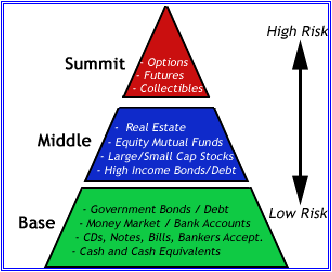Investing in Today’s Markets is All About Managing Risk
Successful investing requires knowledge, experience and the ability to control one’s emotions. The first two factors are easily accomplished with time, effort and the assistance of investment professionals. The last factor requires a different approach, not nearly as apparent as with the first two, but it is the one factor that can undermine the intellectual decision making framework derived from knowledge and experience. The last factor has more to do with your personality, your investment objectives and your tolerance for risk.

Investing is all about managing risk. If you lose sleep at night, it is most likely because you have taken on more risk than your psyche can live with. It just so happens that the different types of investment vehicles can be arranged based on their individual risk profiles, as in the picture below:
As you move up the pyramid, the risk profile increases. Generally, the reason a person takes on a higher level of risk is because the potential for reward in the form of a higher return is highly probable, enough to warrant taking the risk. As you move down the pyramid, the safety of your capital increases, but with lower rates of return.
Your risk tolerance is based on your appreciation objective time horizons and your investing personality, can then be used to choose the type of investments that you want in your portfolio. Investor types fall into two categories, the ones who prefer to “buy-and-hold” an item for the long-term, or the ones who prefer a more active style where trading seeks shorter term gains. The latter involves more risk, with higher potential returns, but more specialized training and knowledge are also necessary before anyone should approach this more complex discipline.
The “Base” investment vehicles are all forms of debt, mostly referred to as bonds or fixed-income securities. These are generally short-term instruments with low risk that pay steady income returns. Government securities may have longer terms, but are regarded as a safer option than high-income corporate bonds.
High-income corporate bonds may offer the potential for higher income payments, but their risk potential and lengthy terms may cause their value to fluctuate. If market interest rates increase, then bond values can go down to compensate, and vice-versa. Capital appreciation or depreciation is a real possibility.
Stocks or equities form the next risk group. The potential for appreciation is the appeal of this choice. Dividend payments, if any, may be low, in the 2-3% range, but long-term capital gains and more favorable tax rates are the real payoff. Companies with large capitalizations, the product of their shares outstanding times their average share price, and generally over $1 billion, have less risk than smaller issues from medium or small cap firms. Penny stocks, the class of stock priced less than $5 a share that trades on an Over-The-Counter exchange, are not bargains. Their risk profile is actually very high. For those who want more diversification of their risk exposure, mutual funds and Exchanged Traded Funds offer the ability to buy shares of a “combination basket” of securities instead of investing directly in the companies themselves individually.
The rest of the securities can all be labeled “alternative investments”. They include real estate, options, commodities, foreign currencies, futures and collectibles. Each category represents a more complicated type of security, along with a more complex investing strategy. Foreign exchange, or Forex, has garnered dramatic popularity over the past five years due to its flexibility and easy access to trading over the Internet. However, special training is a must, a forex broker review is necessary to choose a trusted business partner, and weeks of practice on free demo accounts are mandatory to achieve success at this trading art.
For the beginning investor, the use of alternative investments should be deferred until later in his or her investing career. They are generally high-risk/high-reward securities that are much more speculative than any of the other vehicles listed. Once your knowledge base is broadened and you understand what types of investing suits your personal tastes, you may want to take a tutorial or enroll in a formal class to learn more about alternative vehicles. Impatience and inexperience are recipes for failure and loss of capital for the unprepared. Your teaching professionals will suggest that you focus on building a strong financial foundation before attempting speculative trading.
Investing for the future is a prudent exercise that everyone should learn about at some point on the road to financial security. The process is all about understanding risk, your tolerance of it, and your ability to manage it on a continuing basis. Follow these common sense guidelines and take your first step towards taking care of your financial future. It is the wise thing to do, and you will have fun at it, too!
![]()
